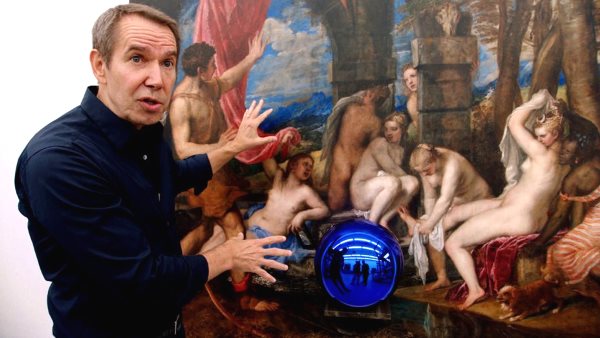
Artist Jeff Koons in front of one of his Gazing Ball paintings in The Price of Everything (HBO Documentary Films)
Director Nathaniel Kahn has a healthy respect for the work of artists, but art collectors? Those he seems to find a bit more problematic. In this ostensibly investigative documentary, he examines the present-day contemporary art market, which tends to view art as a tradable commodity rather than a form of self-expression. Want to put a value on something that is intrinsically impossible to slap a price tag on? Just leave it to the collectors and their co-conspirators, which include dealers and even certain artists.
The film features a wide cross section of players in the contemporary art scene, most of whom never cross paths, although they are generally aware of one another. One of its earliest stops is Frieze New York, an annual fair where collectors, dealers, and critics flock to take in emerging artists and preview the more expensive pieces by name artists that will be making their way to auction houses. Through Frieze, we get an idea of just how global the art market is, and the voraciousness of buyers’ appetites.
We are also introduced to Amy Cappellazzo, the current chairperson for Sotheby’s. She will bring some of the work glimpsed at the fair to a major auction in six weeks. There is no reason to believe the catalogue will not be ready by then, but the intermittent flashing of how many weeks that remain until the big event helps keep the film from seeming too meandering. There are other plotlines involving artists Jeff Koons and Larry Poons, whose careers have taken opposite trajectories, as well as a tour of the extensive collection of Stefan Edlis, a high-profile connoisseur who seemingly represents everything Kahn dislikes about present-day art collectors.
The film spends a significant amount of time profiling Edlis, who, by his own admission, made a name for himself in the art world by overpaying for a Piet Mondrian painting decades ago. Although he owns a lot of contemporary artwork, including quite a few pieces that are among the most highly valued, he appears to view them all as little more than physical objects. When the film cuts from Koons’s opinion on Gazing Ball, one of his seminal art projects, to Edlis speaking about it, the differences could not be clearer. Koons delves into both the symbolism and how the reflective surface of a glass sphere distorts the observer’s perspective in profound ways, while Edlis’s view is that it is superficially pleasing and worthy of display in his collection.
The collector is abetted in his perceived crimes against art by Cappellazzo, whom the film depicts as having a wealth of knowledge devoted to creating effective marketing for Sotheby’s and enriching the homes of her elite clientele. While Kahn occasionally gets her to talk about something other than how much certain works of art are worth, for the most part she is shown in an unflattering light—she is dismissive of comments made by both the director and artists such as Gerhard Richter—and prone to platitudes that do not always hold up to scrutiny. In one scene, Cappellazzo comments that there are three kinds of people in the world—those who see, those who see when shown, and those who never see. Kahn lets that statement dangle in midair where it begs to be elaborated upon, though he himself cannot be bothered to follow-up. (Full disclosure: Cappellazzo was my professor in college, and she is considerably more thoughtful in real life than she appears here.)
The film also spends time evaluating which artists do well in this red-hot market. The answer is those who can churn out work in order to meet demand, which, unfortunately, puts pressure on the artists to compromise their creativity and vision. For a time, Koons is depicted as a master of maximizing his value on the current art market, having devised a system akin to a production line, which results in the manufacturing of just enough art to keep demand sky high. He is actually quite ingenious for having done this, yet Kahn is unable to keep his disdain for Koons from showing. There is a moment in which an acquaintance references Koons’s past as a commodities broker, and Kahn cuts to footage of Leonardo DiCaprio at his junk stock-pushing worst in in The Wolf of Wall Street (2013).
On the other hand, there are figures that the film reveres, such as Poons, who for decades turned his back on the art market. The film regularly checks in on the enormous, multi-easel painting he has been working on, just as it constantly cuts back to George Condo, Njideka Akunyili Crosby, and Marilyn Minter laboring hard at their respective canvases.
The Price of Everything features a running debate as to whether private art collections are all that different from museum collections, but for the most part, the film is about spectacle, as ever-larger amounts of money get thrown at objects that increasingly blur the line between art and—something else. As such, there is an impending apocalypse–vibe that may satisfy those who also enjoyed documentaries such as Lauren Greenfield’s recent Generation Wealth, which also gawked at the antics of the well moneyed. The bottom line is this film may entertain viewers who either appreciate or are interested in modern art, even as it leaves them feeling cynical toward the art market.






Leave A Comment